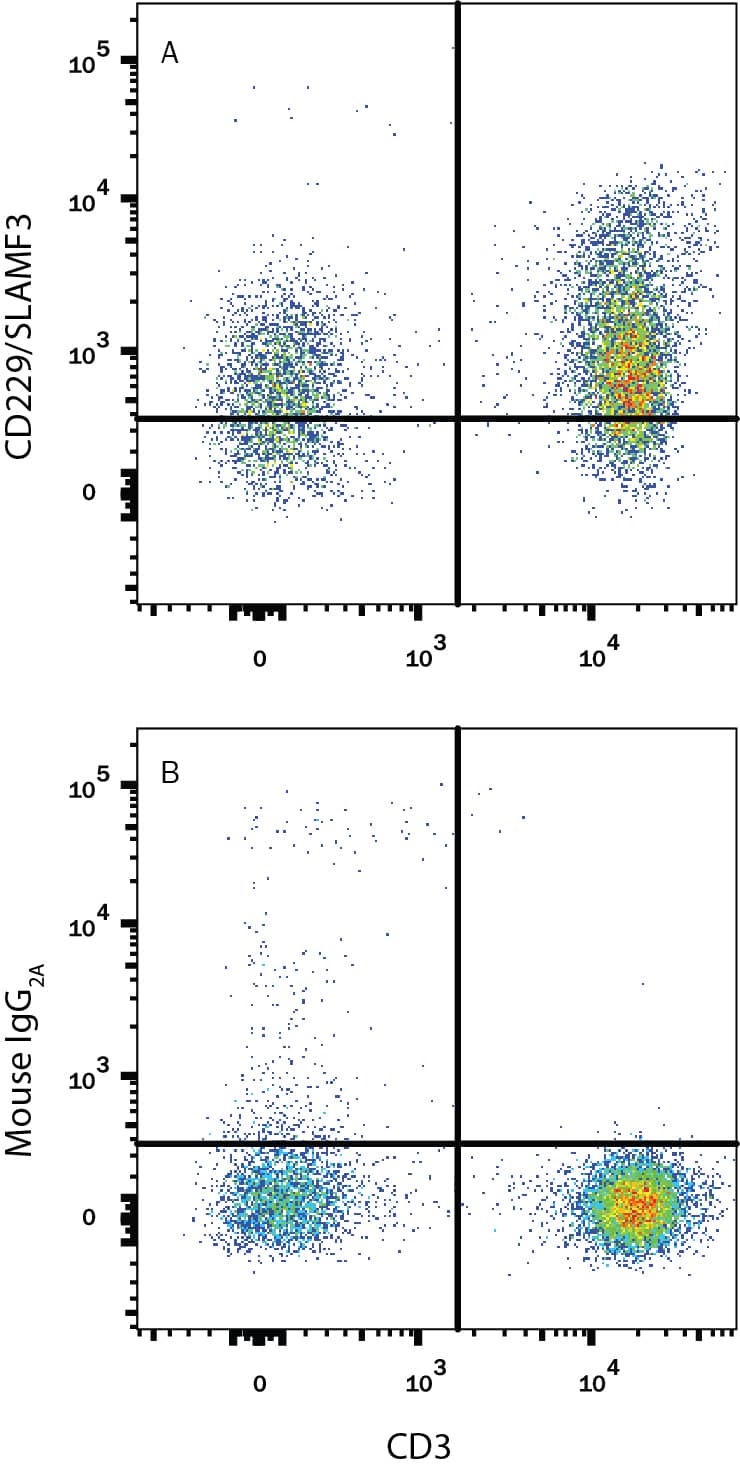Human CD229/SLAMF3 PE-conjugated Antibody
R&D Systems, part of Bio-Techne | Catalog # FAB1898P


Key Product Details
Species Reactivity
Validated:
Cited:
Applications
Validated:
Cited:
Label
Antibody Source
Product Specifications
Immunogen
Lys48-Lys454
Accession # Q9HBG7
Specificity
Clonality
Host
Isotype
Scientific Data Images for Human CD229/SLAMF3 PE-conjugated Antibody
Detection of CD229/SLAMF3 in Human PBMCs by Flow Cytometry.
Human peripheral blood mononuclear cells (PBMCs) were stained with Mouse Anti-Human CD3e APC-conjugated Monoclonal Antibody (Catalog # FAB100A) and either (A) Mouse Anti-Human CD229/SLAMF3 PE-conjugated Monoclonal Antibody (Catalog # FAB1898P) or (B) Mouse IgG2APhycoerythrin Isotype Control (Catalog # IC003P). View our protocol for Staining Membrane-associated Proteins.Applications for Human CD229/SLAMF3 PE-conjugated Antibody
Flow Cytometry
Sample: Human peripheral blood mononuclear cells (PBMCs)
Formulation, Preparation, and Storage
Purification
Formulation
Shipping
Stability & Storage
Background: CD229/SLAMF3
CD229, also known as Ly9 and SLAMF3, is a 120 kDa type I transmembrane glycoprotein in the SLAM subgroup of the CD2 family (1). Mature human CD229 consists of a 407 amino acid (aa) extracellular domain (ECD) with two Ig‑like V-set and two Ig‑like truncated C2-set domains. It also shows a 22 aa transmembrane segment, and a 179 aa cytoplasmic domain with two immunoreceptor tyrosine-based switch motifs ITSMs (2, 3). The ECD of human CD229 shares 57%‑59% aa sequence identity with mouse and rat CD229. Within the first two Ig‑like domains that are common to all SLAM proteins, human CD229 shares 24%‑39% aa sequence identity with human 2B4, BLAME, CD2F-10, CD84, CRACC, NTB-A, and SLAM. Alternate splicing generates two additional isoforms that lack the juxtamembrane Ig‑like domain or short cytoplasmic region (2). CD229 is expressed on T and B cells, thymocytes, and more weakly on NK cells (2‑6). Homophilic binding between CD229 molecules is mediated by the N-terminal Ig‑like domain (7). Human and mouse CD229 exhibit cross-species binding (7). Antigen stimulation of lymphocytes induces CD229 clustering to sites of T cell‑B cell contact (7). Two tyrosines in the cytoplasmic domain are required for association of CD229 with the adaptor proteins AP-2 (μ2 chain) and GRB-2 and both are required for CD229 internalization (8, 9). In addition, there are two ITSMs which mediate phosphorylation-dependent CD229 association with SAP and SHP-2 (10). These four tyrosine-containing motifs are intact in the described CD229 splice variants. CD229 knockout mice show minimally impaired immune responses, suggesting functional redundancy with other molecules (11).
References
- Bhat, R. et al. (2006) J. Leukoc. Biol. 79:417.
- de la Fuente, M.A. et al. (2001) Blood 97:3513.
- Sandrin, M.S. et al. (1992) J. Immunol. 149:1636.
- Romero, X. et al. (2004) Tissue Antigens 64:132.
- Hogarth, P.M. et al. (1980) Immunogenetics 11:65.
- Mathieson, B.J. et al. (1980) J. Immunol. 125:2127.
- Romero, X. et al. (2005) J. Immunol. 174:7033.
- Del Valle, J.M. et al. (2003) J. Biol. Chem. 278:17430.
- Martin, M. et al. (2005) J. Immunol. 174:5977.
- Sayos, J. et al. (2001) Blood 97:3867.
- Graham, D.B. et al. (2006) J. Immunol. 176:291.
Long Name
Alternate Names
Gene Symbol
UniProt
Additional CD229/SLAMF3 Products
Product Documents for Human CD229/SLAMF3 PE-conjugated Antibody
Product Specific Notices for Human CD229/SLAMF3 PE-conjugated Antibody
For research use only